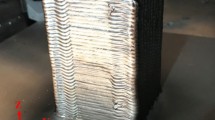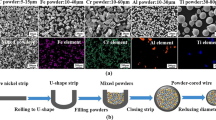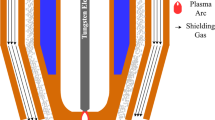Abstract
In electron-beam solid freeform fabrication (EBSFF), material in wire form is fed into a melt pool maintained on the surface of the part by the electron beam, and controlled rapid movement of the part deposits metal selectively in a layer-by-layer fashion. Solidification occurs at a high rate, forming a fine dispersion of primary carbides in Alloy 718. Growth of the carbide particles has been modeled, assuming diffusion control and a linear change in the driving force for precipitation with temperature. The model predicts the maximum carbide size as a function of EBSFF operating parameters and alloy composition. For the material and conditions used experimentally in this work, the model predicts a maximum diameter of approximately 1.0 µm. Extraction-replica transmission electron microscopy of EBSFF samples identified carbides in the 300 to 600 nm range, consistent with a population having the predicted maximum size. Control material from a conventional vacuum-arc remelted ingot was also examined, and platelike carbides up to 40 µm in length were noted. This is an indication of the potential of EBSFF to refine the carbide morphology and size distribution.
Similar content being viewed by others
Abbreviations
- e 1 :
-
L → γ+NbC eutectic reaction point
- e 2 :
-
L → γ+Laves eutectic reaction point
- e 3 :
-
L+γ+NbC → L+γ+Laves class II reaction point
- C:
-
carbon content (weight fraction)
- m :
-
slope of the liquidus (weight fraction/°C)
- X :
-
cooling rate (°C/s)
- t :
-
time (s)
- r :
-
carbide particle radius
- ρ :
-
density (g/cm3)
- M :
-
atomic mass (g/mol)
- D :
-
diffusion coefficient (m2/s)
- R :
-
radial coordinate
- S :
-
temperature range for carbide formation
- a :
-
fatigue-crack length (mm)
- N :
-
number of cycles to failure
- α :
-
pre-exponential fatigue constant
- β :
-
exponential fatigue constant
- L :
-
liquid phase
- NbC:
-
carbide phase
- max:
-
maximum
- faceted:
-
crystallographic fatigue regime
- striated:
-
grain-independent fatigue regime
- transition:
-
transition between fatigue regimes
- critical:
-
fast-fracture regime
- i :
-
interface
- 0:
-
initial
References
D.G. Wilson and T. Korakianitis: The Design of High-Efficiency Turbomachinery and Gas Turbines, 2nd ed., Prentice-Hall, Upper Saddle River, NJ, 1998, pp. 564–65.
J.M. Hyzak and S.H. Reichman: in Advances in High Temperature Structural Materials and Protective Coatings, A.K. Koul, V.R. Paraweswaran, J.-P. Immarigeon, and W. Wallace, eds., National Research Council of Canada, Ottawa, Canada, 1994, p. 140.
A.S. Ballantyne, A. Mitchell, and J.F. Wadier: Proc. 6th Int. Vacuum Metallurgy Conf., Noyes Publications, Park Ridge, NJ, 1979, pp. 599–623.
J.M. Poole: Proc. 9th Int. Vacuum Metallurgy Conf. on Special Melting, Noyes Publications, Park Ridge, NJ, 1989, pp. 508–39.
V.R. Davé: Ph.D. Thesis, Massachusetts Institute of Technology, Cambridge, MA, 1995.
J.A. Halbleib et al.: ITS Version 3.0: The Integrated TIGER Series of Coupled Electron/Photon Monte Carlo Transport, SAND-1634, Sandia National Laboratory, Albuquerque, NM, 1992.
D. Rosenthal: Trans. AIME, 1946, vol. 43, pp. 849–66.
T.W. Eagar and N.S. Tsai: Welding J., 1983, vol. 62, pp. 346s-355s.
J.N. Dupont, C.V. Robino, J.R. Michael, M.R. Notis, and A.R. Marder: Metall. Mater. Trans. A., 1998, vol. 29A, pp. 2785–96.
H.L. Eiselstein: Advances in the Technology of Stainless Steels, ASTM STP 369, 1965, ASTM, Philadelphia, PA, pp. 62–79.
B. Radhakrishnan and R.G. Thompson: Metall. Trans. A, 1989, vol. 20A, pp. 2866–68.
J.N. Dupont, C.V. Robino, and A.R. Marder: Acta Mater., 1998, vol. 46, pp. 4781–90.
H.B. Aaron, D. Fainstein, and G.R. Kotler: J. Appl. Phys., 1970, vol. 41, pp. 4404–10.
R.D. Doherty: in Physical Metallurgy: Part II, J.W. Cahn and P. Haasen, eds., North-Holland Physics Publishing, Amsterdam, The Netherlands, 1983, pp. 964–66.
T. Denda, P.L. Bretz, and J.K. Tien: Metall. Trans. A, 1992, vol. 23A, pp. 519–26.
R. Vincent: Acta Metall., 1985, vol. 33, pp. 1205–16.
T. Banik, P.W. Keefe, G.E. Maurer, and L. Petzold: Proc. Superalloys 718, 625, and Various Derivatives, TMS, Warrendale, PA, 1991, pp. 913–24.
E. Beraha: Praktische Metallographie, 1968, vol. 5, pp. 443–51.
Author information
Authors and Affiliations
Rights and permissions
About this article
Cite this article
Matz, J.E., Eagar, T.W. Carbide formation in alloy 718 during electron-beam solid freeform fabrication. Metall Mater Trans A 33, 2559–2567 (2002). https://doi.org/10.1007/s11661-002-0376-y
Received:
Issue Date:
DOI: https://doi.org/10.1007/s11661-002-0376-y




